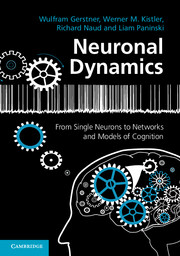Book contents
- Frontmatter
- Contents
- Preface
- PART ONE FOUNDATIONS OF NEURONAL DYNAMICS
- PART TWO GENERALIZED INTEGRATE-AND-FIRE NEURONS
- 5 Nonlinear integrate-and-fire models
- 6 Adaptation and firing patterns
- 7 Variability of spike trains and neural codes
- 8 Noisy input models: barrage of spike arrivals
- 9 Noisy output: escape rate and soft threshold
- 10 Estimating parameters of probabilistic neuron models
- 11 Encoding and decoding with stochastic neuron models
- PART THREE NETWORKS OF NEURONS AND POPULATION ACTIVITY
- PART FOUR DYNAMICS OF COGNITION
- References
- Index
7 - Variability of spike trains and neural codes
Published online by Cambridge University Press: 05 August 2014
- Frontmatter
- Contents
- Preface
- PART ONE FOUNDATIONS OF NEURONAL DYNAMICS
- PART TWO GENERALIZED INTEGRATE-AND-FIRE NEURONS
- 5 Nonlinear integrate-and-fire models
- 6 Adaptation and firing patterns
- 7 Variability of spike trains and neural codes
- 8 Noisy input models: barrage of spike arrivals
- 9 Noisy output: escape rate and soft threshold
- 10 Estimating parameters of probabilistic neuron models
- 11 Encoding and decoding with stochastic neuron models
- PART THREE NETWORKS OF NEURONS AND POPULATION ACTIVITY
- PART FOUR DYNAMICS OF COGNITION
- References
- Index
Summary
The neuron models discussed in the previous chapters are deterministic and generate, for most choices of parameters, spike trains that look regular when driven by a constant stimulus. In vivo recordings of neuronal activity, however, are characterized by a high degree of irregularity. The spike train of an individual neuron is far from being periodic, and correlations between the spike timings of neighboring neurons are weak. If the electrical activity picked up by an extracellular electrode is made audible by a loudspeaker then what we basically hear is noise. The question whether this is indeed just noise or rather a highly efficient way of coding information cannot easily be answered. Indeed, listening to a computer modem or a fax machine might also leave the impression that this is just noise. Being able to decide whether we are witnessing the neuronal activity that is underlying the composition of a poem (or the electronic transmission of a love letter) and not just meaningless flicker is one of the most burning problems in neuroscience.
Several experiments have been undertaken to tackle this problem. It seems that a neuron in vitro, once it is isolated from the network, can react in a very reliable and reproducible manner to a fluctuating input current, and so can neurons in the sensory cortex in vivo when driven by a strong time-dependent signal. On the other hand, neurons produce irregular spike trains in the absence of any temporally structured stimuli. Irregular spontaneous activity, i.e., activity that is not related in any obvious way to external stimulation, and trial-to-trial variations in neuronal responses are often considered as noise.
Information
- Type
- Chapter
- Information
- Neuronal DynamicsFrom Single Neurons to Networks and Models of Cognition, pp. 168 - 201Publisher: Cambridge University PressPrint publication year: 2014
